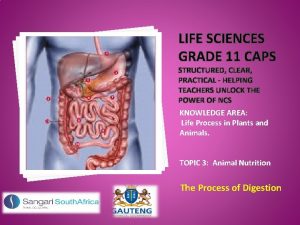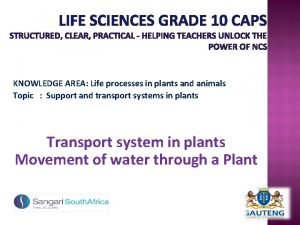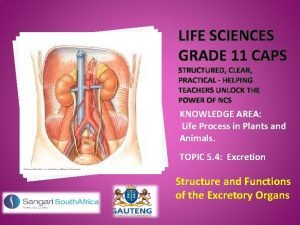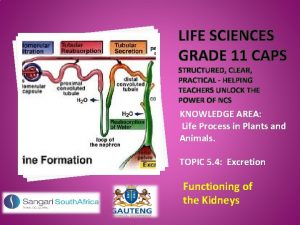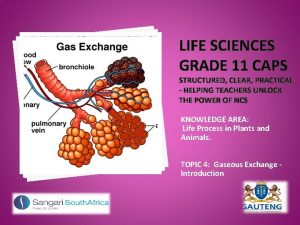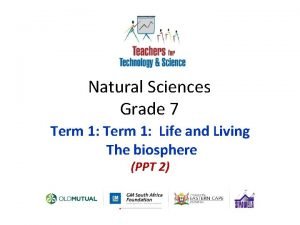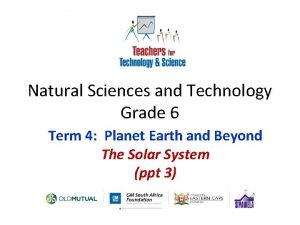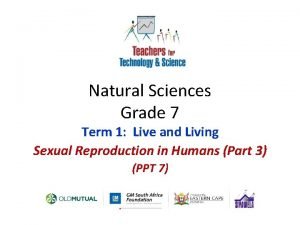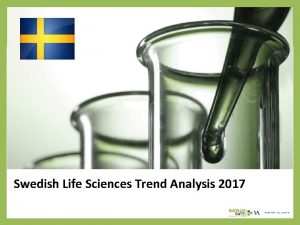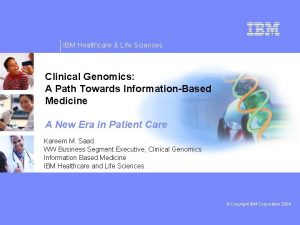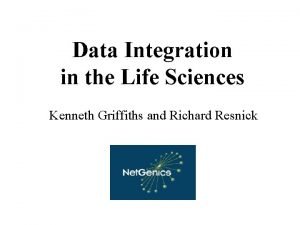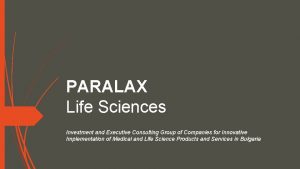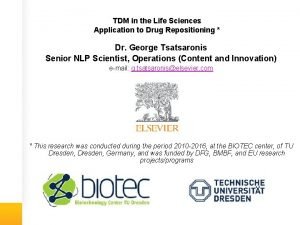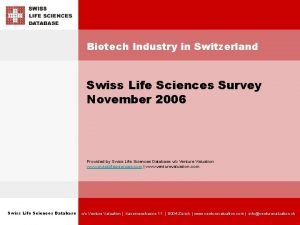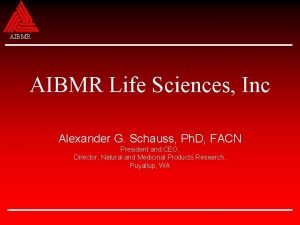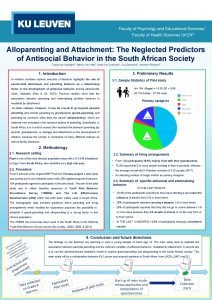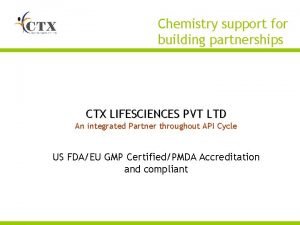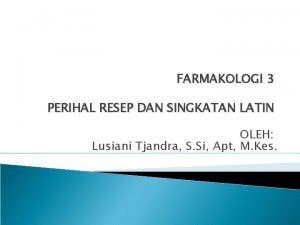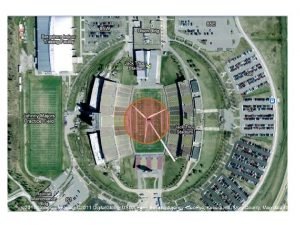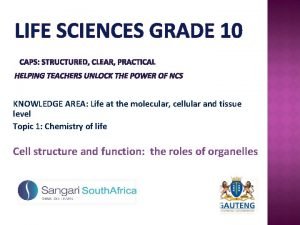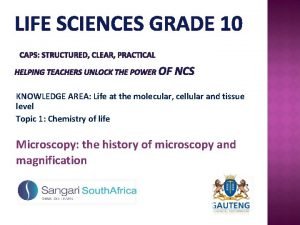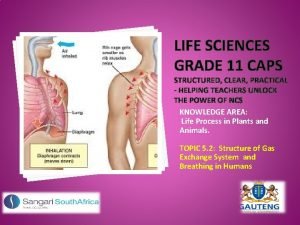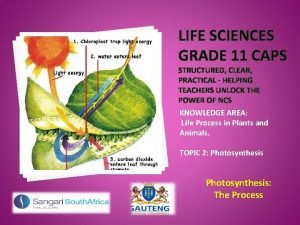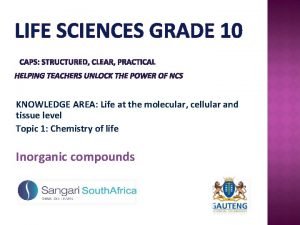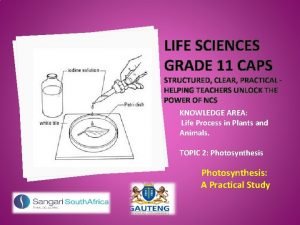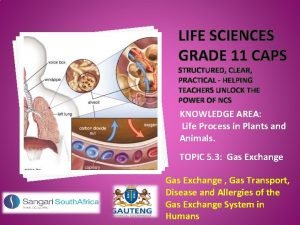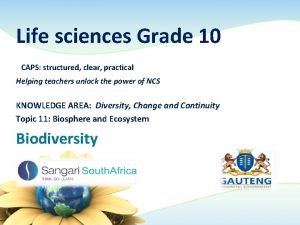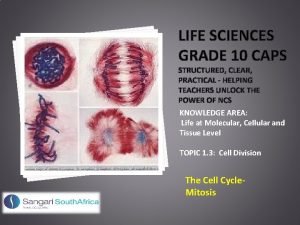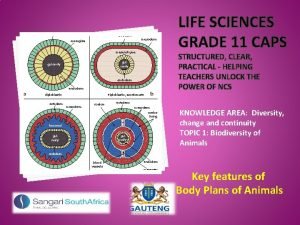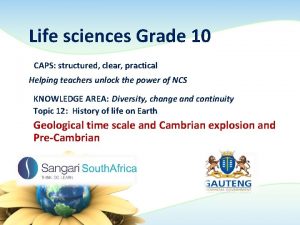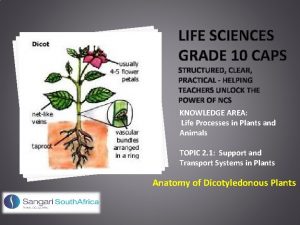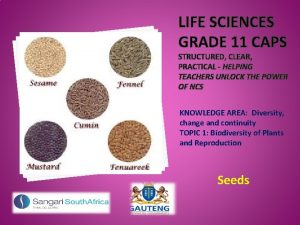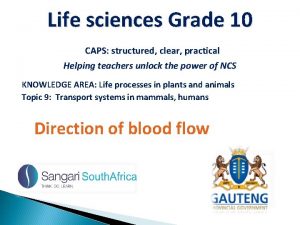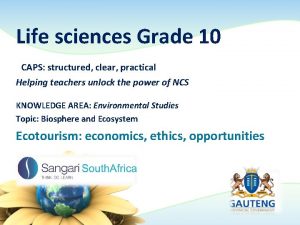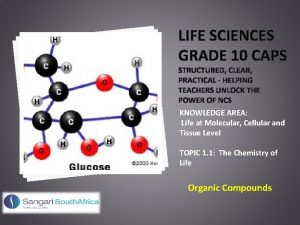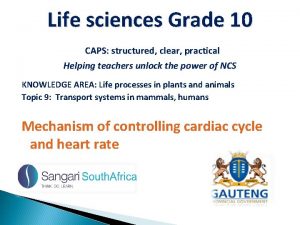LIFE SCIENCES GRADE 11 CAPS STRUCTURED CLEAR PRACTICAL

















































- Slides: 49

LIFE SCIENCES GRADE 11 CAPS STRUCTURED, CLEAR, PRACTICAL - HELPING TEACHERS UNLOCK THE POWER OF NCS KNOWLEDGE AREA: Life Process in Plants and Animals. TOPIC 4: Gaseous Exchange Introduction

SUMMARY OF THE PRESENTATION: The Need for Gaseous Exchange The Need for Oxygen Requirements of an Efficient Gas Exchange System Adaptations of both Plants and Animals for an Efficient Gas Exchange Surface Area : Volume Ratio

THE NEED FOR GAS EXCHANGE � The main purpose of the gaseous exchange is to ensure that oxygen enters the organism. � The oxygen is then used for cellular respiration. � During cellular respiration energy is released. � However carbon dioxide is released as a by-product. � Carbon dioxide cannot be allowed to accumulate in the body. � Because if the carbon dioxide collects to high levels then it combines with water to from carbonic acid. � The carbonic acid changes the p. H of the tissue fluid.

THE NEED FOR GAS EXCHANGE � This change in p. H affects the functioning of the enzymes. Can anyone explain why?

SOLUTION: Yes that’s right enzymes are sensitive to changes in p. H. A change in p. H can denature the enzyme.

THE NEED FOR GAS EXCHANGE � Therefore carbon dioxide needs to leave the organism. � Gas exchange ensures that the carbon dioxide is brought to the surface of the organism. � From the surface it can be easily excreted.

THE NEED FOR OXYGEN � One of the most important functions of the gas exchange system is to bring oxygen to organism. � The oxygen is required for the process of cellular respiration. � Remember during cellular respiration oxygen is used to break down the glucose to release energy. � We shall look at how this oxygen enters the body and how the carbon dioxide that is released as a by-product leaves the body.

THE NEED FOR OXYGEN � The oxygen enters and carbon dioxide leaves the body through the process of breathing. � The oxygen then needs to move from the lungs into the bloodstream and then the cells. � The carbon dioxide must move from the cells into the bloodstream and finally to the lungs. � This process is known as gaseous exchange.

THE REQUIREMENTS OF AN EFFICIENT GAS EXCHANGE SYSTEM: The following are the requirements of an efficient gas exchange system: 1. 2. 3. A large surface area must be present to ensure that large of amounts of oxygen are taken in and large amounts of carbon dioxide are breathe out. This surface area must be moist, so that the gas exchange surface do not become dry or desiccate. The gas exchange surface must be thin to allow for quick diffusion of gases.

THE REQUIREMENTS OF AN EFFICIENT GAS EXCHANGE SYSTEM: 4. The gas exchange system must have a transport system to carry the gases to or from the gas exchange surface. good ventilating mechanism 5. A must be present to ensure gases rich is oxygen is drawn in and carbon dioxide is driven out. 6. The gas exchange surface must be because this surface is thin and delicate. protected Now lets look at some examples of gas exchange surface of different organism and how organisms are adapted to ensure that these surfaces are efficient.

ADAPTATIONS FOR AN EFFICIENT GAS EXCHANGE SURFACE 1. a. b. Large surface area The lungs of humans are made up of millions of tiny air sacs called alveoli. This increase surface area. All green parts of the plant contains large number of stomata and even the woody stems have large amounts of lenticels. This ensures large amounts of oxygen and carbon dioxide enter and leave the plant. Alveoli of the human lung Stomata

ADAPTATIONS FOR AN EFFICIENT GAS EXCHANGE SURFACE c. d. e. The skin of the earthworm is used as a gas exchange surface. This creates a large surface area. Insects contain a large number of spiracles which increase the surface area. The gills of fish are made up of many filaments. This increases the surface area. Earthworm Spiracles of caterpillar

ADAPTATIONS FOR AN EFFICIENT GAS EXCHANGE SURFACE The gas exchange surface must be kept moist. The following are the adaptations to keep the gas exchange surface moist. a. The lungs of humans are kept moist by a thin film of water. b. The spongy mesophyll cells of the leaf acts as a gas exchange surface. These mesophyll cells are also surround by a layer of moisture. c. The earthworm’s skin is kept moist by coelomic fluid and mucus. It is also kept moist because it lives in damp soil. 2.

ADAPTATIONS FOR AN EFFICIENT GAS EXCHANGE SURFACE c. In the bee, liquid is found at the end of the tracheal tube, keeping it moist. d. The gills of the fish are kept moist because the fish lives in water.

ADAPTATIONS FOR AN EFFICIENT GAS EXCHANGE SURFACE 3. The gas exchange surface must be thin to allow for rapid diffusion. The following are adaptations that ensures a thin gas exchange surface… a. The alveoli of humans are made up of squamous epithelium. The squamous is made up of only 1 layer of cells. These cells are further flattened, making the surface even thinner. b. The mesophyll tissue is made up of the mesophyll cells that are thinned walled. This makes the gas exchange surface thin.

ADAPTATIONS FOR AN EFFICIENT GAS EXCHANGE SURFACE c. The earthworm is surrounded by a thin epidermis. d. In insects the cells are surrounded by a thin cell membrane only. e. The gill filaments of fish are thin.

ADAPTATIONS FOR AN EFFICIENT GAS EXCHANGE SURFACE 4. A transport system must be present to transport gases away quickly. The organisms are adapted to provide a transport system in the following ways… a. The alveoli are surrounded by a large number of blood capillaries. b. The mesophyll tissue have a large number of intercellular air spaces that allows for the easy movement of gases.

ADAPTATIONS FOR AN EFFICIENT GAS EXCHANGE SURFACE c. The earthworm has a large number of blood capillaries below the epidermis. d. Insects like the locust have a system of tracheal tubes that carry the gases throughout the body. e. The gills of the fish have a large number of capillaries.

ADAPTATIONS FOR AN EFFICIENT GAS EXCHANGE SURFACE 5. An adequate ventilating system must be present to ensure gases are drawn in and pumped out. Organisms have the following adaptations to meet the above requirement. a. The ribs, intercostals muscles and diaphragm of the human act together to bring about ventilation. b. Plants do not require a ventilating mechanism because the gases simply diffuse in and out of the plant.

ADAPTATIONS FOR AN EFFICIENT GAS EXCHANGE SURFACE c. The same for the earthworm because the gases move into and out of the organism through diffusion. d. The insects such as the locust have tergo-sternal muscles that bring about ventilation. e. Oxygen enters the gills of the fish when water with dissolved oxygen passes over the gill slits.

ADAPTATIONS FOR AN EFFICIENT GAS EXCHANGE SURFACE 6. The gas exchange surface is extremely thin and delicate therefore it must be protected. The organisms have the following protective measures…

ADAPTATIONS FOR AN EFFICIENT GAS EXCHANGE SURFACE a. b. In humans the lungs are protected by the rib cage. The rib cage is made up of the ribs, sternum, the vertebral column and the intercostal muscles. The mesophyll cells are found within the leaf and therefore is protected. Rib cage of Humans

ADAPTATIONS FOR AN EFFICIENT GAS EXCHANGE SURFACE c. d. e. The skin of the earthworm is protected by the coelomic fluid and mucous. The tracheal system of insects are found within the body of the organism and is therefore protected in this way. The spiracles which are found on the outside of the organism are covered by spiracle flaps. The gills of fish are covered by gill flaps. This provides the protection.

GAS EXCHANGE AND SURFACE AREA: VOLUME RATIO � Rate of gas exchange is dependent on the organism’s surface area. � The surface area is the area that is in contact with the surrounding environment. � Therefore the ability to meet the gas requirements of the organism depends on the surface area to volume ratio. � As an organism increases in size both its surface area and volume increases, but… � The volume increases more than its surface area.

GAS EXCHANGE AND SURFACE AREA: VOLUME RATIO �A large surface area is an advantage since more gases will enter the organism. � As an organism gets larger its surface area: volume ratio gets smaller. � Smaller organisms have a larger surface area when compared to their volume. � Large organisms have smaller surface areas when compared to their volume. � Therefore a smaller surface area is exposed to atmospheric gases. � A transport system must be present to transport the gases away from the gas exchange surface to ensure that the entire organism gets the gases.

GAS EXCHANGE AND SURFACE AREA: VOLUME RATIO � Surface area: volume ration is calculated as follows Surface area: volume ratio =

TERMINOLOGY: Cellular respiration: is the process during which glucose is broken down to release energy. � Carbonic acid: is formed when carbon dioxide mixes with water. � Gaseous exchange: is the process during which one gas is exchange for another. � Spiracles: these are the external respiratory opening on the � body of an insect. Gills: respiratory organs of fish � Spongy mesophyll cells: these are the round to oval shaped mesophyll cells in the leaf. � Squamous epithelium: flattened, thin walled tissue making up the alveoli. � Sternum: breast bone �

QUESTION 1 1. Oxygen is necessary for… A. B. C. D. Cellular respiration Photosynthesis Both A and B None of the above

QUESTION 2 2. Gaseous exchange is necessary to ensure that… A. Oxygen enters the human body and carbon dioxide leaves the body B. Carbon dioxide enters the human body and oxygen leaves the body C. Oxygen enters the leaf and carbon dioxide leaves the leaf D. Carbon dioxide enters the body of the fish and oxygen leaves the fish

QUESTION 3 3. If carbon dioxide accumulates in the human body… A. B. C. D. Carbonic acid is formed The p. H of the tissue fluid is lowered The function of the enzymes are affected All of the above

QUESTION 4 4. An efficient gas exchange must be… A. B. C. D. Thin to ensure rapid diffusion of gases Thick to ensure that the surfaces are strong Both A and B None of the above

QUESTION 5 5. A large gas exchange… A. Must be present to ensure a more gases enter and leave the organism B. Is achieved in humans by the large number of alveoli in the lungs C. A only D. Both A and B

QUESTION 6 6. The gas exchange surface must be… A. Thick for protection B. Occur within a rib cage in humans for protection C. Thin and small in size to ensure a large amount of gases enter the body D. Dry for rapid diffusion of gases

QUESTION 7 7. Air rich in oxygen is only able to be drawn into the body if… A. B. C. D. The gas exchange surface is thin The gas exchange surface is protected A ventilating system is present Gas exchange must be moist

QUESTION 8 8. The many stomata of the leaves ensures… A. B. C. D. A thin gas exchange surface A moist gas exchange surface An increased surface area The presence of a ventilating mechanism

QUESTION 9 9. The rib cage of the human provides… A. B. C. D. Protection for the gas exchange surface A ventilating mechanism B only Both A and B

QUESTION 10 10. The earthworm has a rich capillary network to… A. B. C. D. Increase surface area Ensure the gas exchange surface is moist Transport the gases to and from the cells None of the above

QUESTION 11 11. The mesophyll cells have… A. B. C. D. Thick cell walls to ensure rapid diffusion Thin cell walls to allow for rapid diffusion Thick cell walls for protection Both A and C

QUESTION 12 12. The gas exchange surface of the insect is kept moist by… A. Spiracles that open to the exterior B. Tracheal tubes that go to the inner parts of the insect and therefore is kept moist C. A liquid found at the end of the tracheal tubes D. None of the above

QUESTION 13 13. The tergo-sternal muscles of the locust … A. B. C. D. Protects the gas exchange surface Acts as a ventilating mechanism Keeps the gas exchange surface moist None of the above

QUESTION 14 14. The gas exchange surface of the angel fish is thin because… A. B. C. D. The gill filaments are thin Gills are divided into many gill filaments Fish lives in water It has a rich supply of blood vessels

QUESTION 15 15. The gas exchange surface of the earthworm is large because … A. It contains many spiracles B. It contains many stomata C. The skin and thus the entire surface of the organism is used D. It has many alveoli

QUESTION 16 16. The earthworm does not need a ventilating mechanism because… A. B. C. D. It contains many muscles The gases enter and leaves the organism by diffusion The gases enters the organisms through the spiracles None of the above

QUESTION 17 17. The gas exchange surface of the leaf is protected… A. B. C. D. Because the mesophyll cells are found inside the leaf By the rib cage By the gill cover By chitinous flaps

QUESTION 18 18. The gas exchange surface of the insect is protected… A. B. C. D. Because the mesophyll cells are found inside the leaf By the rib cage By the gill cover By chitinous flaps

QUESTION 19 19. A large organism A. B. C. D. Has a small surface area when compared to its volume Has a large surface area Surface area: volume ratio is the large Both A and C

QUESTION 20 20. As an organism increases in size A. B. C. D. Only its volume increases It volume increases more than its surface area Its surface area increases more than its volume Both its volume and surface area decreases

SOLUTION 1. 2. 3. 4. 5. 6. 7. 8. 9. 10. A A D B C C D C 11. 12. 13. 14. 15. 16. 17. 18. 19. 20. B C B A D A B

TERMINOLOGY TERM: Photosynthesis Photo – light Synthesis – to make DEFINITION: USE IN SENTENCE: Photosynthesis is the Plants are autotrophic process during which the because they make their green plant uses the own food by photosynthesis. radiant energy from the sun to make food.
 Grade 11 life sciences animal nutrition
Grade 11 life sciences animal nutrition Natural sciences tok
Natural sciences tok Disadvantages of unstructured interviews
Disadvantages of unstructured interviews How can we integrate oop with sd/sa ?
How can we integrate oop with sd/sa ? In march
In march Excretion grade 11
Excretion grade 11 Life science grade 11 kidney practical
Life science grade 11 kidney practical Life science grade 11 gaseous exchange practical
Life science grade 11 gaseous exchange practical Types of maps in mathematical literacy
Types of maps in mathematical literacy Ns tech grade 6 term 2
Ns tech grade 6 term 2 Natural science grade 7 biosphere
Natural science grade 7 biosphere Term 4 natural science grade 7
Term 4 natural science grade 7 What is energy grade 7
What is energy grade 7 Term 4 natural science grade 6
Term 4 natural science grade 6 Natural science grade 4 term 2 test papers
Natural science grade 4 term 2 test papers Animal nutrition grade 11 practical
Animal nutrition grade 11 practical Natural science grade 7 term 2 notes pdf
Natural science grade 7 term 2 notes pdf Natural science grade 7 term 3
Natural science grade 7 term 3 Swedish life sciences
Swedish life sciences Ibm healthcare and life sciences
Ibm healthcare and life sciences Data integration in the life sciences
Data integration in the life sciences Paralax life sciences
Paralax life sciences Colors life sciences
Colors life sciences Life sciences
Life sciences Cti life sciences fund
Cti life sciences fund Lsssdc certificate download
Lsssdc certificate download Ibm healthcare and life sciences
Ibm healthcare and life sciences Swiss life sciences
Swiss life sciences Meril life sciences
Meril life sciences Aibmr life sciences
Aibmr life sciences Life sciences universal data framework
Life sciences universal data framework Mcb 317 uiuc
Mcb 317 uiuc School of life sciences ukzn
School of life sciences ukzn Ctx life sciences pvt. ltd.
Ctx life sciences pvt. ltd. Daily life real life polynomial problems
Daily life real life polynomial problems Caps saude mental
Caps saude mental Sig e caps
Sig e caps Singkatan resep
Singkatan resep Sigecaps
Sigecaps Subject improvement plan for mathematics grade 12
Subject improvement plan for mathematics grade 12 Sigicaps
Sigicaps Fiu caps
Fiu caps Penulisan resep dexamethasone
Penulisan resep dexamethasone Sig e caps
Sig e caps Cognitive levels of assessment: intermediate phase
Cognitive levels of assessment: intermediate phase History fet caps
History fet caps Caps 71-1
Caps 71-1 Spar cap
Spar cap Caps and floors
Caps and floors Abridged caps document
Abridged caps document
